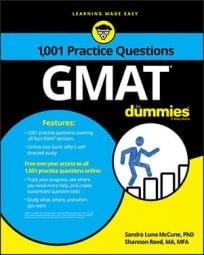Each Data Sufficiency problem poses a question, followed by two statements. Your task is to evaluate the statements to determine at what point there is or is not sufficient information to answer the question.
Unlike the Problem Solving questions, you do not actually have to answer the question posed. Instead, you select one of five fixed answer choices that offer different options about the sufficiency of the information provided in the two statements.
Practice questions
- The heights of a certain plant species are normally distributed. What height is 2 standard deviations greater than the arithmetic mean height of the plant species?
(1) The arithmetic mean height is 32.8 centimeters.
(2) The standard deviation of the heights is 2.4 centimeters.
A. Statement (1) ALONE is sufficient, but statement (2) alone is not sufficient to answer the question asked.
B. Statement (2) ALONE is sufficient, but statement (1) alone is not sufficient to answer the question asked.
C. Both statements TOGETHER are sufficient, but NEITHER statement ALONE is sufficient to answer the question asked.
D. Each statement ALONE is sufficient to answer the question asked.
E. Statements (1) and (2) TOGETHER are NOT sufficient to answer the question asked.
- Harper interviewed for a job with company A and with company B. What is the probability that Harper will get job offers from both companies?
(1) The probability that Harper will get a job offer from exactly one of the companies is 0.6.
(2) The probability that Harper will get a job offer from neither company is 0.1.
A. Statement (1) ALONE is sufficient, but statement (2) alone is not sufficient to answer the question asked.
B. Statement (2) ALONE is sufficient, but statement (1) alone is not sufficient to answer the question asked.
C. Both statements TOGETHER are sufficient, but NEITHER statement ALONE is sufficient to answer the question asked.
D. Each statement ALONE is sufficient to answer the question asked.
E. Statements (1) and (2) TOGETHER are NOT sufficient to answer the question asked.
Answers and explanations
- The correct answer is C.
Let h = the height that is 2 standard deviations greater than the mean height. Then h = mean + 2(standard deviation). From (1), h = 32.8 cm + 2(standard deviation). Without knowing the standard deviation, you cannot determine an exact value of h. Thus, (1) is not sufficient.
From (2), h = mean + 2 (2.4 cm). Without knowing the mean, you cannot determine an exact value of h. Thus, (2) is not sufficient.
Taking (1) and (2) together, h = 32.8 cm + 2(2.4 cm), which you can calculate to determine an exact value of h. Therefore, both statements together are sufficient, but neither statement alone is sufficient.
- The correct answer is C.
Let P(both) = the probability Harper will get a job offer from both companies, P(exactly one) = the probability Harper will get a job offer from exactly one of the two companies, and P(neither) = the probability that Harper will get a job offer from neither company. Given that one of these three events is certain to happen, then P(both) + P(exactly one) + P(neither) = 1, from which you have P(both) = 1 – P(exactly one) – P(neither). From (1) P(both) = 1 – 0.6 – P(neither). Without additional information, you cannot determine an exact value of P(both). Thus, (1) is not sufficient.
From (2), P(both) = 1 – P(exactly one) – 0.1. Without additional information, you cannot determine an exact value of P(both). Thus, (2) is not sufficient.
Taking (1) and (2) together, P(both) = 1 – 0.6 – 0.1 = 0.3. Therefore, both statements together are sufficient, but neither statement alone is sufficient.

